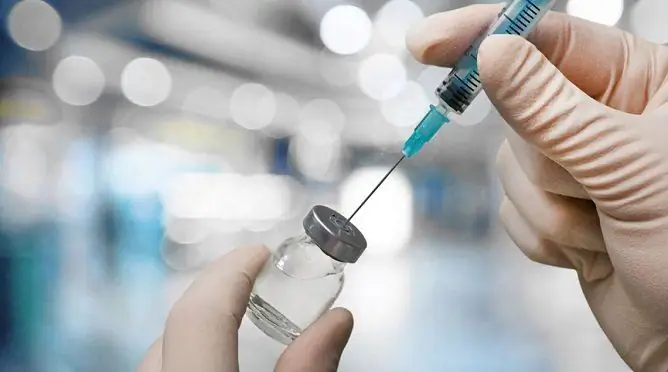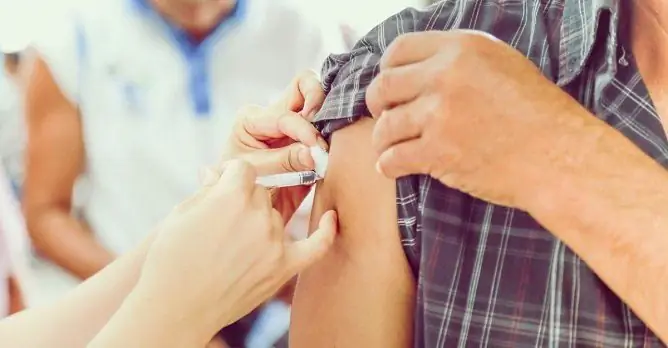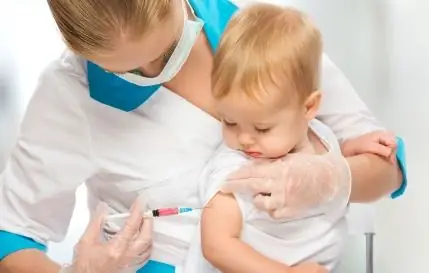- Author Rachel Wainwright [email protected].
- Public 2023-12-15 07:39.
- Last modified 2025-11-02 20:14.
Gardasil
Gardasil: instructions for use and reviews
- 1. Release form and composition
- 2. Pharmacological properties
- 3. Indications for use
- 4. Contraindications
- 5. Method of application and dosage
- 6. Side effects
- 7. Overdose
- 8. Special instructions
- 9. Application during pregnancy and lactation
- 10. Use in childhood
- 11. Use in the elderly
- 12. Drug interactions
- 13. Analogs
- 14. Terms and conditions of storage
- 15. Terms of dispensing from pharmacies
- 16. Reviews
- 17. Price in pharmacies
Latin name: Gardasil
ATX code: J07BM01
Active ingredient: recombinant antigens - protein L1 of human papillomavirus types 6, 11, 16 and 18
Vendor: Merck Sharp & Dohme Idea Inc. (USA)
Description and photo update: 2019-14-08
Prices in pharmacies: from 9415 rubles.
Buy

Gardasil is a vaccine used to prevent diseases caused by the human papillomavirus.
Release form and composition
Gardasil is produced in the form of a suspension for intramuscular administration: white, opaque (0.5 ml each in glass vials with a capacity of 3 ml or in glass disposable syringes with a capacity of 1.5 ml, complete with 1 or 2 sterile needles and a device for safe administration or without it, 1 or 10 vials or syringes in a cardboard box).
The composition of 0.5 ml (1 dose) contains the active substance: L1 human papillomavirus protein - 0.12 mg, including:
- Type 6 - 0.02 mg;
- Type 11 - 0.04 mg;
- Type 16 - 0.04 mg;
- Type 18 - 0.02 mg.
Auxiliary components: sodium chloride - 9.56 mg, amorphous aluminum hydroxyphosphate sulfate - 0.225 mg, polysorbate 80 - 0.05 mg, L-histidine - 0.78 mg, sodium borate - 0.035 mg, water for injection - 0.5 mg …
The suspension does not contain antibiotics and preservatives.
Pharmacological properties
Pharmacodynamics
Immunobiological properties
The Gardasil vaccine forms protective immunity with the development of cellular and humoral immune responses against the human papillomavirus (HPV). For sexually active people without vaccination, the lifetime risk of contracting HPV exceeds 50%, and this figure is constantly increasing. The Gardasil vaccination course contributes to the prevention of diseases caused by HPV.
Clinical efficacy
Studies conducted with the involvement of more than 24,000 girls and women aged 16-45 years and more than 4,000 boys and men aged 16-26 years have confirmed the high safety and effectiveness of the drug.
In women aged 16-26 years, Gardasil effectively prevented precancerous dysplastic conditions and cancer of the cervix, vagina, vulva, and also in 98-100% of cases prevented the appearance of anogenital warts. Based on the analysis of data on the cross-protective efficacy of Gardasil, it was concluded that it is effective in reducing the risk of developing adenocarcinoma in situ and cervical intraepithelial neoplasia 1/2/3 degree caused by common oncogenic types of human papillomavirus that are not included in the vaccine.
Further, over the course of 8 years, a long-term clinical study of 16-26-year-old women vaccinated with Gardasil who were part of the Protocol Effectiveness Population (PPE) group, that is, 3 vaccinations within a year, was conducted in addition to the main study FUTURE II. The results show no cases of cervical intraepithelial neoplasia of any degree caused by human papillomavirus type 18, 16, 11 or 6. The duration of protection in this study was statistically confirmed at 6 years.
For women 24-45 years old, in 88.7% of cases, the effectiveness of the Gardasil vaccine was recorded in the prevention of persistent infection, cervical intraepithelial neoplasia of any degree, or anogenital lesions caused by human papillomavirus 18, 16, 11 or 6 types.
For women 24-45 years old who were vaccinated with Gardasil, who were part of the Protocol Effectiveness Population (PPE) group, a long-term clinical study was conducted in addition to the main study FUTURE III for 6 years. During this period, no cases of cervical intraepithelial neoplasia of any degree or genital warts caused by human papillomavirus 18, 16, 11 or 6 types were reported.
The use of the Gardasil vaccine in men and adolescents in 90.6% of cases contributed to the prevention of HPV infection of 18, 16, 11 or 6 types, which causes external genital lesions (grade 1-3 intraepithelial neoplasia of the penis, perineal and perianal intraepithelial neoplasia, anogenital condylomas), and in 77.5% of cases, it prevented grade 1-3 anal intraepithelial neoplasia.
The duration of protection against anal cancer is unknown at this time. In the Gardasil-vaccinated men aged 16-26 years, who were followed in the main study (according to Protocol 020) and belonged to the population of efficacy according to the protocol (PPE), then an additional long-term clinical study was carried out. In this category of patients, no cases of diseases caused by HPV (anogenital warts, external genital lesions, and anal intraepithelial neoplasia of any degree) have been recorded for 6 years.
Immunogenicity
As a result of the full course of vaccination, more than 98% of vaccinated people develop specific antibodies to four types of HPV (types 18, 16, 11 and 6).
During vaccination of seropositive patients, the presence of an immunological memory was recorded. Along with this, in persons who received an additional dose of the vaccine 5 years after the full course of vaccination, the presence of a rapid, pronounced anamnestic immune response was noted, in which the values of the geometric mean antibody titers exceeded those obtained 1 month after the first course of vaccination.
The efficacy of the vaccine in boys and girls aged 9-15 years has been demonstrated based on the method of immune bridging. After vaccination in the main study (Protocol 018), boys and girls aged 9-15 years were followed up in an additional long-term clinical study.
It has been proven that the Gardasil vaccine protects women and girls 9-26 years old from diseases of cervical intraepithelial neoplasia of 1-3 degrees or adenocarcinoma in situ caused by HPV types 58, 52, 33 and 31.
Immune response to two-dose Gardasil vaccination
In a clinical study, it was demonstrated that in girls 9-13 years old (n = 259) who received 2 doses of Gardasil (scheme 0-6 months) for 7 months after the first dose, the immune response was not lower than in women aged 16-26 years (n = 310) who received 3 doses of Gardasil (scheme 0-2-6 months). The duration of immune protection in the case of two-dose Gardasil vaccination has not been established.
Pharmacokinetics
There are no data on the pharmacokinetics of Gardasil.
Indications for use
According to the instructions, Gardasil is prescribed for the prevention of diseases caused by the human papillomavirus (HPV).
Girls and women (ages 9 to 45):
- Cancer of the anal canal, vagina, vulva and cervix (caused by HPV types 16 and 18);
- Intraepithelial neoplasia of the vagina (VaIN) and vulva (VIN) 1/2/3 degree (HPV 6, 11, 16 and 18 types);
- Adenocarcinoma of the cervix uteri in situ (AIS), cervical intraepithelial neoplasia 1/2/3 degree (CIN) (HPV types 6, 11, 16 and 18);
- Condyloma acuminata (anogenital warts) (HPV types 6 and 11);
- Intraepithelial neoplasia of the anal canal 1/2/3 degree (HPV 6, 11, 16 and 18 types).
In girls and women (ages 9 to 26), Gardasil may provide protection against non-vaccine HPV-related diseases.
Boys and men (ages 9 to 26):
- Condyloma acuminata (anogenital warts) (HPV types 6 and 11);
- Anal cancer (HPV 16 and 18 types);
- Precancerous, dysplastic conditions and intraepithelial neoplasia of the anal canal 1/2/3 degree (HPV 6, 11, 16, 18 types).
Contraindications
A contraindication to the use of Gardasil is hypersensitivity to the components of the drug.
With the development of symptoms of hypersensitivity to the drug, the administration of subsequent doses of the vaccine is contraindicated.
A relative contraindication to therapy is blood clotting disorders due to thrombocytopenia, hemophilia, or while taking anticoagulants. If it is necessary to use the vaccine in this category of patients, it is necessary to evaluate the potential benefits of vaccination with an associated risk. When vaccinating in these cases, measures must be taken to reduce the risk of post-injection hematoma formation.
There are no data on the effectiveness and safety of using Gardasil in children under 9 years of age and adults over 45 years of age.
Instructions for the use of Gardasil: method and dosage
Gardasil should be injected intramuscularly into the upper outer surface of the middle third of the thigh or deltoid muscle. The vaccine is not intended for intravenous administration.
A single dose of Gardasil for all age groups is 0.5 ml.
The recommended course of vaccination is 3 doses, it should be carried out according to the scheme (0-2-6 months):
- 1 dose - on the appointed day;
- 2 dose - 2 months after the introduction of the first;
- 3 dose - 6 months after the introduction of the first.
An accelerated vaccination schedule (0-1-3 months) is possible.
In case of violations of the interval between Gardasil vaccinations, the course of vaccination can be considered completed if 3 vaccinations have been administered within 1 year.
The need for revaccination has not been established.
If the first dose of Gardasil was used for vaccination, then the full course of vaccination must be carried out using this drug.
Before administration, the package (syringe / vial) with the vaccine should be shaken until a homogeneous cloudy suspension is obtained. If there is a loss of homogeneity, the appearance of incorporated particles and a change in the color of the suspension, the vaccine cannot be administered.
The Gardasil vaccine-filled syringe is intended for single use only and for one person only.
The vaccination procedure and opening of the vials must be carried out with strict adherence to the rules of antisepsis and asepsis. Before and after the injection, the injection site should be treated with 70% alcohol.
The entire recommended single dose (0.5 ml) should be administered.
Side effects
During the use of Gardasil, the following disorders may occur (> 10% - very often;> 1% and 0.1% and 0.01% and <0.1% - rarely; <0.01% - very rarely):
- Respiratory system: very rarely - bronchospasm;
- Musculoskeletal system: often - pain in the limbs;
- Local reactions: very often - redness, swelling and pain; often - hematoma, itching (in most cases, local reactions were mild);
- General disorders: often - pyrexia.
With the post-registration use of Gardasil, spontaneous information was received about the development of the following side effects in vaccinated, it is not possible to reliably assess the relationship with the vaccine and the frequency of which:
- Nervous system: headache, Guillain-Barré syndrome, dizziness, acute primary idiopathic polyradiculoneuritis, acute disseminated encephalomyelitis, fainting, in some cases accompanied by tonic-clonic seizures;
- Lymphatic and hematopoietic system: idiopathic thrombocytopenic purpura, lymphadenopathy;
- Musculoskeletal system: myalgia, arthralgia;
- Digestive system: vomiting, nausea;
- Parasitic and infectious diseases: cellulite;
- Allergic reactions: hypersensitivity reactions (including anaphylactoid / anaphylactic reactions), urticaria and bronchospasm;
- General disorders: chills, asthenia, discomfort, fatigue.
Overdose
There is evidence of cases of administration of Gardasil in a dose exceeding the recommended one. At the same time, the severity and nature of undesirable effects were comparable to similar effects when using the recommended single doses of Gardasil.
special instructions
When deciding on the need for vaccination, it is necessary to compare the possible risk from previous HPV infection with the potential benefit from its implementation.
Gardasil is not intended for the treatment of cancer of the cervix, vagina or vulva, CIN, VaIN or VIN, or active condylomatosis. The use of the drug is possible only for prophylactic purposes. The vaccine is designed to prevent infection with HPV types that the patient does not have. The vaccine has no effect on the course of HPV-induced active infections.
As with the introduction of any other vaccine, with the use of Gardasil, a protective immune response cannot be obtained in all vaccinated persons. The drug does not protect against sexually transmitted diseases with a different etiology. Because of this, vaccinated patients should be encouraged to continue using other prophylactic remedies.
Subcutaneous and intradermal administration of the drug is not recommended due to the lack of data on the safety and efficacy of the drug using these methods.
In the treatment and prophylactic office, in which vaccination is carried out, there should be medicines for the immediate relief of an anaphylactic reaction and anti-shock and emergency therapy.
Within 30 minutes after the administration of the vaccine, it is necessary to monitor the patient's condition for the timely detection of post-vaccination reactions and complications, as well as the provision of emergency medical care. Fainting may develop during vaccination, especially in young women and adolescents.
The decision to administer Gardasil or to postpone vaccination due to a current or recent illness with fever is determined by the etiology of the disease and the severity.
In case of impaired reactivity of the immune system due to the use of immunosuppressants (systemic corticosteroids, antimetabolites, alkylating and cytotoxic drugs), genetic defects, HIV infection and other reasons, the protective effect may be reduced.
Gardasil should be administered with caution to patients with thrombocytopenia and any blood clotting disorders, since after intramuscular injection such patients may develop bleeding.
Prior to vaccination, health care personnel should provide all relevant vaccine information to patients, caregivers and parents, including information on benefits and associated risks.
Any adverse reactions should be reported to your doctor. Vaccination is not a substitute for routine screening. In the absence of contraindications to achieve effective results, the vaccination course should be completed completely.
Application during pregnancy and lactation
There are no data on the adverse effects of Gardasil vaccine on fertility, pregnancy and fetal health. There are no specially designed and well-controlled studies of the vaccine in pregnant women. There is insufficient information on the use of Gardasil during pregnancy and on the possible effects of the vaccine on the reproductive function of women and on the fetus to recommend its use in pregnant women.
The patient should be warned about the need to prevent pregnancy during the course of vaccination, and in case of pregnancy, vaccination should be stopped before its completion.
In clinical trials of the efficacy, immunogenicity and safety of the vaccine in lactating women and infants, it has been shown that Gardasil can be used during lactation.
Pediatric use
In childhood, the Gardasil vaccine should be done with caution. The safety and efficacy of the vaccine in children under 9 years of age has not been evaluated.
Use in the elderly
In old age, Gardasil should be used with caution. The safety and efficacy of the vaccine in individuals over 45 years of age have not been evaluated.
Drug interactions
Gardasil can be co-administered (at a different site) with a recombinant hepatitis B vaccine, a meningococcal vaccine conjugated with a diphtheria toxoid, and an inactivated vaccine against poliomyelitis, tetanus, diphtheria, pertussis (acellular component).
Analogs
The analogue of Gardasil is Cervarix.
Terms and conditions of storage
Store in a dark place, out of reach of children, at a temperature of 2-8 ° C, do not freeze.
The shelf life is 3 years.
Once removed from the refrigerator, Gardasil should be administered as quickly as possible. Outside the refrigerator (at a temperature of 25 ° C or lower), you can keep the drug for no longer than 72 hours.
Terms of dispensing from pharmacies
Dispensed by prescription. Designed for treatment-and-prophylactic and sanitary-preventive institutions.
Reviews about Gardasil
Reviews of Gardasil from doctors and patients are quite diverse, but most doctors are positive about the use of the vaccine (subject to mandatory consultation with a doctor and vaccination in a medical institution).
Price for Gardasil in pharmacies
The approximate price for Gardasil is 7120 rubles. for 1 dose of 0.5 ml.
Gardasil: prices in online pharmacies
|
Drug name Price Pharmacy |
|
Gardasil 0.5 ml / dose suspension for intramuscular administration 0.5 ml 1 pc. RUB 9415 Buy |
|
Gardasil 0.5 ml / dose suspension for intramuscular administration 0.5 ml 1 pc. RUB 9416 Buy |

Anna Kozlova Medical journalist About the author
Education: Rostov State Medical University, specialty "General Medicine".
Information about the drug is generalized, provided for informational purposes only and does not replace the official instructions. Self-medication is hazardous to health!






